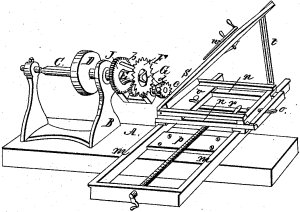 |
| Image for patent 12,482, granted 1855-03-06 |
In June of 1843, Franklin Averill Gleason (born 1821-07-28 in Lorraine, Jefferson County, NY, died 1890-02-26 in Brooklyn, NY), having trained as a jeweler and horologist, opened a jewelry and clock shop at the corner of James and Dominick streets in Rome, N. Y. In 1846 he took silversmith John Storrs Hovey in as a partner, an arrangement that lasted a couple of years. After that we lose track of Mr. Gleason. In 1854 he patented a reed keyboard instrument, and then the following year he patented a machine for cutting mitred and sliding dovetail joints. An article was published in Scientific American about his invention and it won an award at the 1855 Fair of the American Institute. Beginning in 1855, he manufactured and sold the machine under the F. A. Gleason name. In 1863 he patented improvements to his machine. The following year one John M. Nichols of Brooklyn was granted a reissue (correction) to that patent, with himself as assignee. Gleason had no role in applying for the reissue. In 1886, a Franklin Averill Gleason of Brooklyn obtained a Canadian patent for a nailing machine.
Information Sources
- The 1848 Bulletin of the American Art Union contains a list of members, including J. S. Hovey and F. A. Gleason of Rome, N. Y.
- 1854-07-01 Scientific American.
- Article in 1855 Scientific American, which describes how a pair of small circular saws are controlled by a treadle, the whole machine "occupying but little more space than a man's hat." The machine, for creating mitered dovetail joints, costs $60 to $75, depending on size.
- List of Premiums awarded by the managers of the 27th Annual Fair of the American Institute, October, 1855 lists a diploma awarded to F. A. Gleason, Rome, N. Y., for a mitre and dovetail machine.
If the inventor will allow us to insert the word "grooving," we can recommend this instrument as very useful in manufactures where neatness, not strength, is required at the joints; and where a dove-tailed groove is required in the solid wood, it will apply in strong work. But as a dovetailing machine, thence inferring a claim to supersede the instruments that makes genuine dove-tails for strong work, we should pass it as useless. The principle is, to form a dovetailed groove in the mitre of one piece, and a dovetailed tongue in the mitre of the adjoining piece, at any desired angle, according to the number of sides desired; the mitre and tongue in one piece, or the mitre and groove on the other being formed at one operation by means of two cutters flaring from two that are at right angles with the motion, the former cutting the groove or tongue, and the latter the mitre. The proper angle is given by an adjustible frame upon which the obards are slid along as the cutters remove the wood. [A diploma awarded.]
- An 1863 article in Scientific American describes Gleason's exhibit at the Fair of the American Institute; the joints produced by Gleason's mitering dovetailer are described as "perfect" and "watertight."
- The 1864 reissue of patent 37,910 was assigned to one John M. Nichols of Brooklyn, NY; there is no other information on that person.
- 1864 Manual of the Common Council of the City of Brooklyn lists cash contributions to the Brooklyn and Long Island Fair through the Grocer's and Hardware Committee, including $250 from J. M. Nichols, 27 Sands street.
- A PDF document on lorsonbooksandprints.com has an entry, "John Storrs Hovey 1. He was a partner from 1846 to 1848 with F. A. Gleason in Rome NY as GLEASON & HOVEY."
- The 1896 book, Buisness Interest of Rome, NY in 1848, ed. Daniel E. Wagner: "Francis Bicknell was in jewelry trade near there and also J. S. Hovey." Gleason is not mentioned.
- The 1989 book, Kovels' American Silver Marks, by Ralph M. Kovel, lists "Gleason & Hovey (c. 1846-1848) / Rome, N. Y. / F. A. Gleason / J. S. Hovey"